Introduction
This is an abridged description of a six weeks journey with a free round trip ticket to Damascus by rail (German Railway employee perk) in the autumn of 1963. The intention is to give a first hand personal experience of how I did get to and through the countries of Turkey, Syria, Jordan and Lebanon.
Despite the fact that I did not book anything in advance at all, except applying for a visa for Syria, it was no problem getting any means of transport or hotel accommodation, though many times I was invited by Arabs.
However, I will not suggest to travel that route all by yourself during these dangerous times now. I am describing already a historic journey, which can not be repeated in that way anymore, maybe only after Palestine has become a peaceful place (that was the case in 1963 when the West-Bank belonged to Jordan, and Israel was well protected by a border and wall).
I will not describe much or show any map of Turkey here. I only stayed three days in Istanbul and just one day in Ankara, also some photos have been lost throughout all those past years.
The following map shows my itinerary marked with a yellow line (on maps being carried in Arab countries, Israel had to be wiped out):
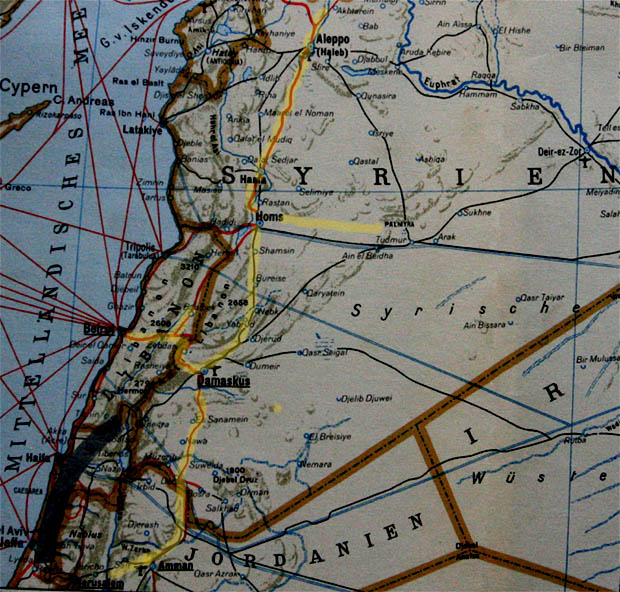
|
Why and how did I get to Syria.
The why: I had an invitation by a Syrian industrialist in Aleppo, whom I met on a train ride between Berlin and Cologne. He wanted to visit the Hardware Fair in Cologne to look for business opportunities for his hardware plants in Syria. After some correspondence (in French), I decided to travel to Aleppo.
The how: I boarded the then "Orient Express" (not with a murder) going to Athen. In order to get to Istanbul, I had to change trains in Thessaloniki (with one overnight stay). In Istanbul I stayed for three nights in a cheap hotel for 7 Deutsch Mark (DM), intermingling with a Turkish youth gang and doing some sight-seeing partially together with a German guy I met. I liked Istanbul.
Next I had to continue east by taking the Taurus Express leaving from the other, the Asian side of the Bosporus (to be reached by boat at that time). Ankara was just a day's stopover: arriving in the morning, sightseeing during the day (where I visited the Hittites Museum and the Ata Turk's Mausoleum) and leaving again in the evening.
Still the Taurus Express coming from Istanbul I had to board. Was then still lucky to find one available seat in one compartment of six. While arranging the suitcases in the upper luggage storage net to get my rucksack stowed away, some guy sitting at the window shouted at me what I was doing up there. I answered that I was making room. That guy was traveling to Baghdad, the final destination of the Taurus Express. It may have very well been Saddam Hussein, 26 years old at that time. He was very unfriendly during the whole trip and didn't introduce himself.
But another guy just did that: Abdullah, just 24 years old, a teacher from Homs in Syria who had visited the International Boy Scout meeting in London. He was impressed by the way I have responded to the Iraqi. We became friends during the long train ride and he invited me in his home in Homs.
Getting back to Saddam: While trying to find out his age, I found an article about his life: Saddam Hussein really came back to Iraq in 1963 from Cairo, where he studied law for four years, not really voluntarily. He was part of an assassination attempt on the Iraq president Abdul Karem Kassim in 1959. Both were injured in a gun battle and Saddam had to flee to Egypt and only dared to come back after the ousting and execution of Kassim in 1963. A convenient route to Baghdad was through Turkey (if not flying), or he had some business to do in Istanbul. The direct land route via Sinai was blocked by Israel, so he had to take a ship first anyway.
Aleppo
With a five hours delay we arrived in Aleppo in the middle of the night. As soon as I did get off the train I already heard somebody shouting "Deutschland, Deutschland". It was my friend, Mustafa Sabsabi, who had been waiting all night and inquired several times at the station about the new arrival time of my train.
I stayed in his house for a week. And he was such a good host. I never experienced anything like this. I could sleep as long as I wanted. He was watching for the first sign of it in order to close all the courtyard windows of his wife's quarters (kitchen, etc.), because I was not allowed to see her while passing her windows to get to the bathroom.
Then Mustafa and I had breakfast at a ready-set table. All my laundry I left in the room in the morning was washed and ironed in the evening when I came home. Once I did get a glimpse of his wife when I turned around quickly while leaving the house one morning, she was looking after me, probably curious too, though Mustafa didn't notice that.
He also drove me around all day, sight-seeing, visiting his friends, checking on his hardware store, inspecting the construction of his new plant (he introduced me as his German quality control engineer), and having lunch at nice restaurants. What he did not allow me, was getting to a bank to change some money into the local currency. Conversation was French only, because he could not speak English (Syria was French protectorate before).
There were actually not many photos taken. They were all slides, and some did get lost. The few which I kept over all those years haven't had the best protection, so they are looking like hundred years old (instead of 45), though I tried to refurbish some.
Remark: The photos on the right side may not be correctly adjusted if you use Mozilla Firefox or Chrome. I propose to use the Explorer of Microsoft instead.
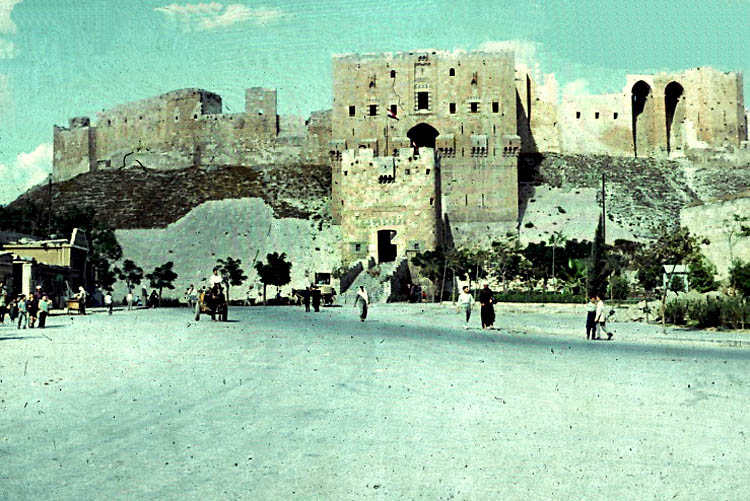
| Aleppo citadel |

| Look from the Aleppo citadel |
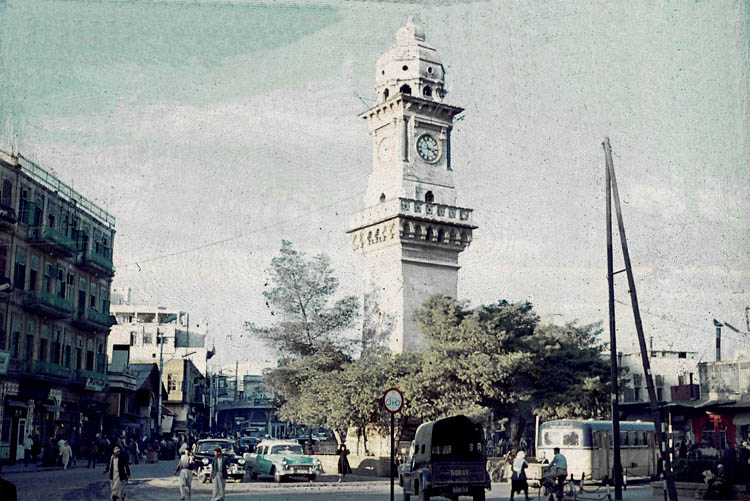
| Aleppo main plaza with clock tower |

| Aleppo modern apartment houses |
Homs
Finally, I continued to Homs on the way to Damascus, not by train (despite my ticket's validity till Damascus), but by taxi (mostly cars of American make), which was very cheap. As soon as I arrived in Homs I went to the home of Abdullah, who was really happy to see me. I stayed a couple of days.
This town was a Roman colony in the 3rd century. Zenobia, the queen of Palmyra, was defeated here by the Roman army also during that time.
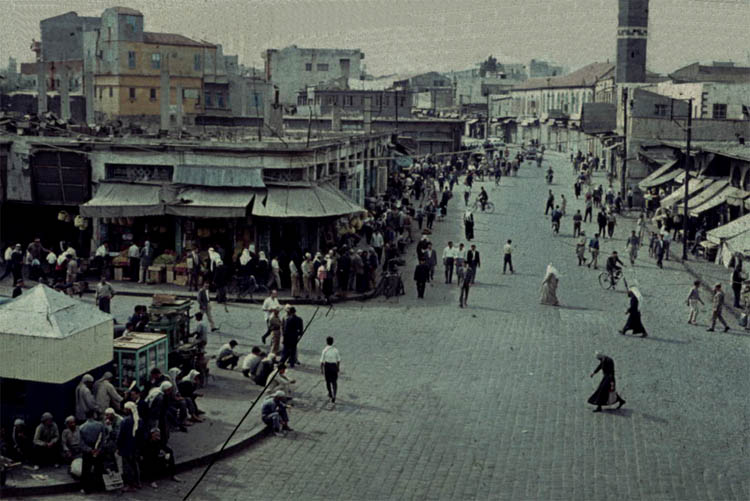
| Homs plaza |
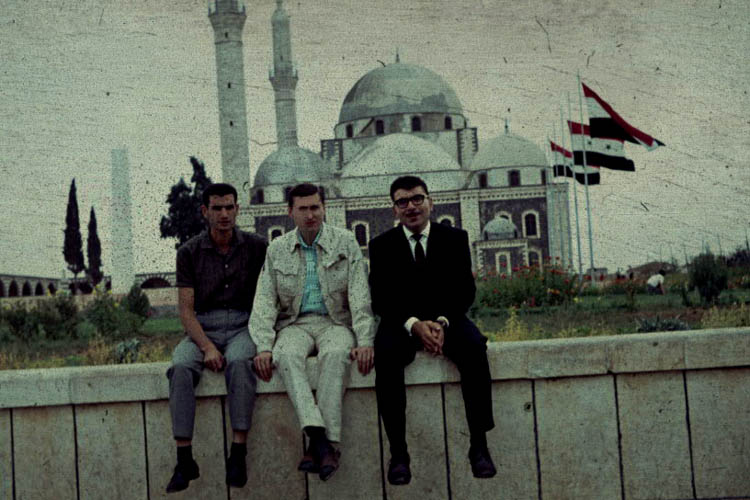
| Homs mosque |

| With Abdulla (left) and friend |
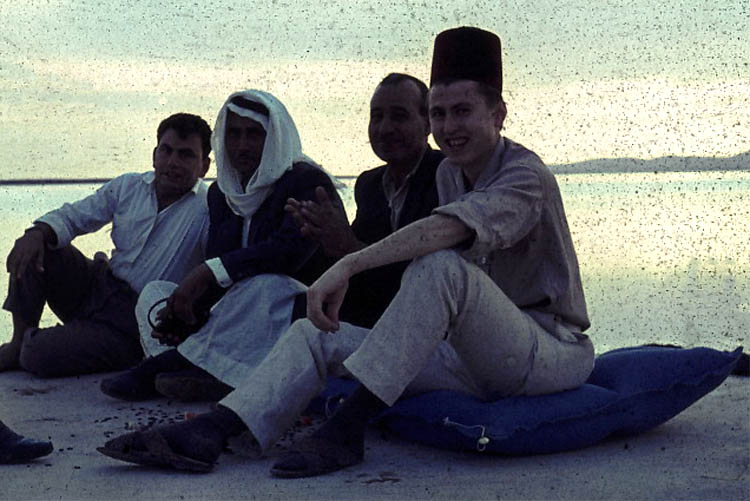
| Trip to the Homs lake |
Palmyra
Palmyra was a caravan station in the 1st Century BC. It became a Roman outpost and a major city-state within the Roman Empire in the 1st Century AD. In the 3rd Century AD the famous Zenobia ruled from here all of Syria, Egypt, and most of Asia Minor. This was disliked by the Romans, and in 272 Emperor Aurelian captured her and sacked Palmyra.
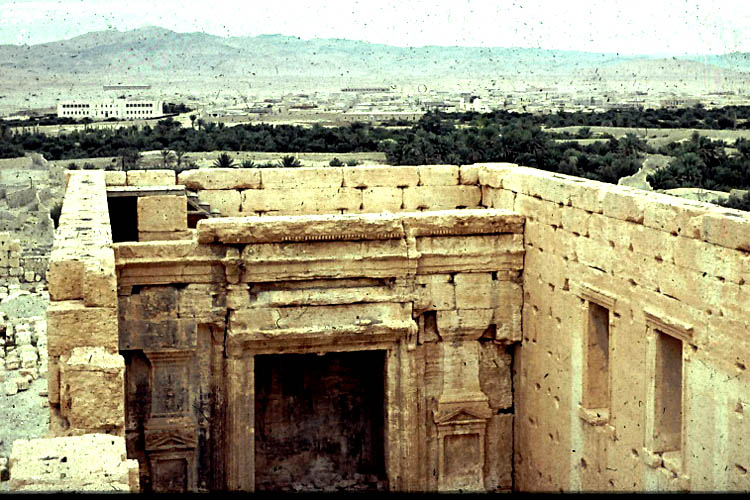
| Palmyra temple |
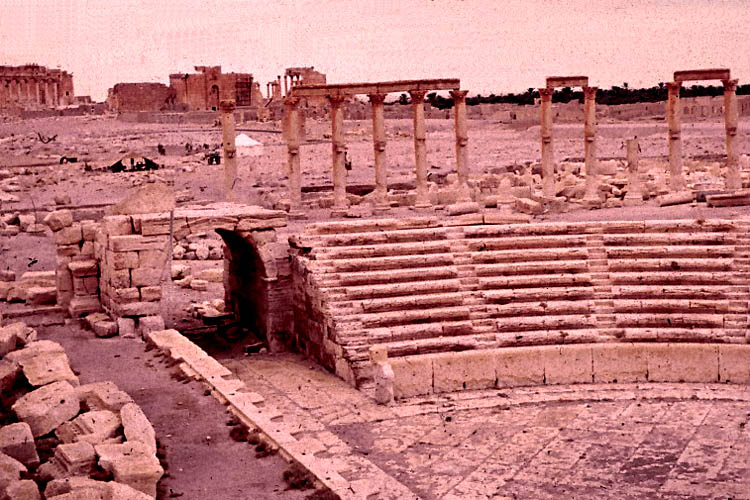
| Amphi-theater |
Next day I said good bye to Abdullah and hopped on the bus again going back to Homs, with a short stopover in the middle of the desert to pray against (sorry, not against but in the direction of) Mecca at sunset. After a night in a hotel in Homs I took a taxi to Damascus, my next destination.
Damascus
One of the friends of Abdullah, a student, invited me to stay with him in Damascus where he studies. But this time I did not want to take advantage of the hospitality of a poor student and took a hotel.
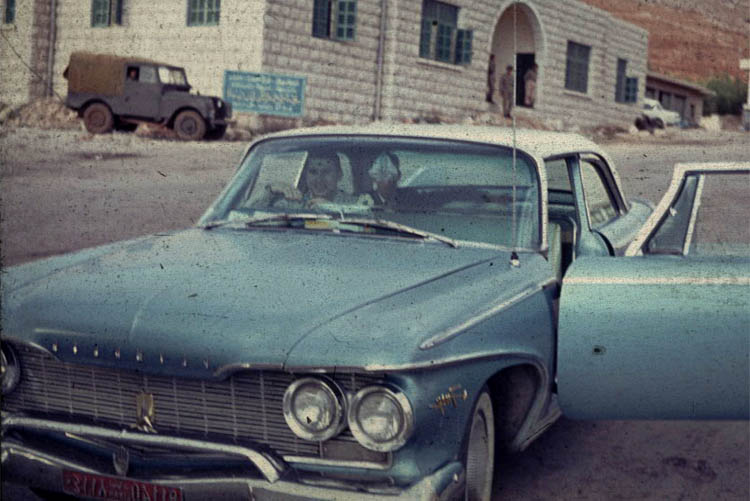
| On the way to Damascus |
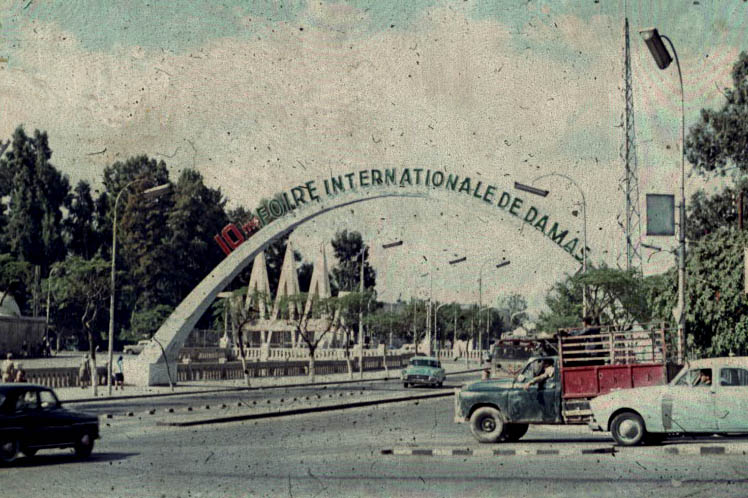
| Arriving in Damascus |
So it was a must to visit some of them, especially the most important one, the Umayyad Mosque. Walking through the suqs is always a shopping adventure, though I did not buy anything.
On my sight-seeing tour I was accompanied by the student I met in Homs before. In the evening we also met many of his student friends and we had a big discussion about history and politics. I did not always agree, definitely not that Hitler was a good man, because he killed Jews. But still, one student also objected and meant if he (Hitler) had won the war then also all Arabs might have been killed.
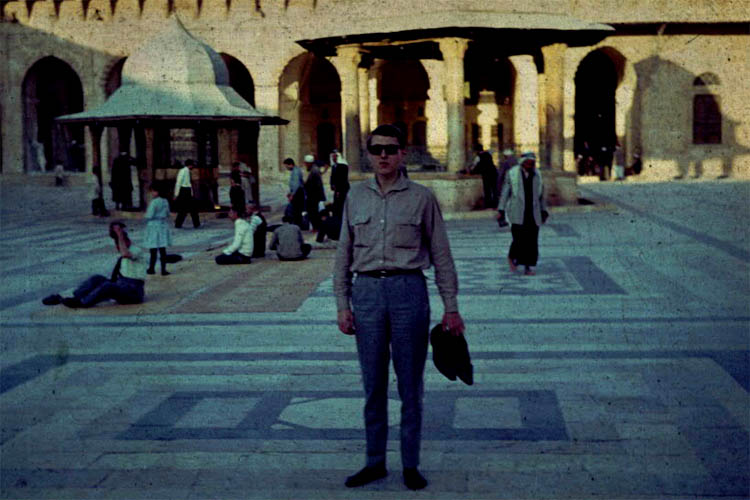
| Praying in a Damascus mosque |
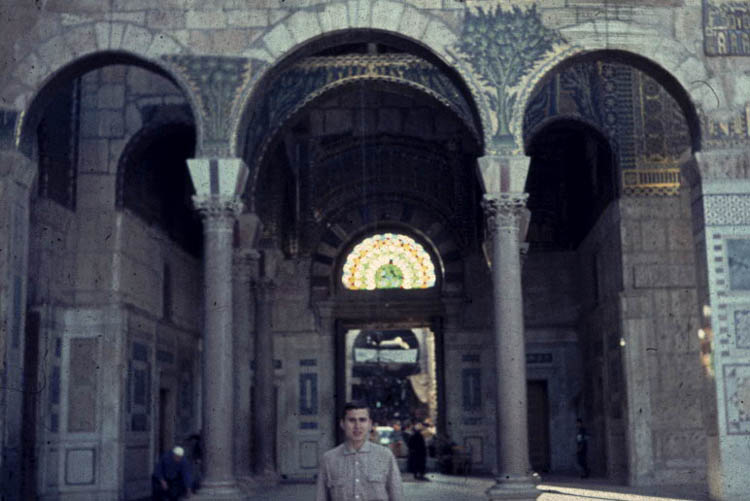
| and visiting the Umayyad mosque |
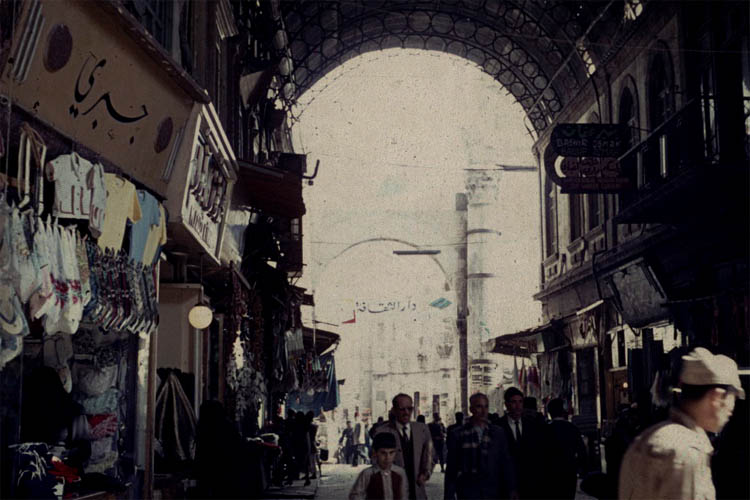
| Suq in Damascus |
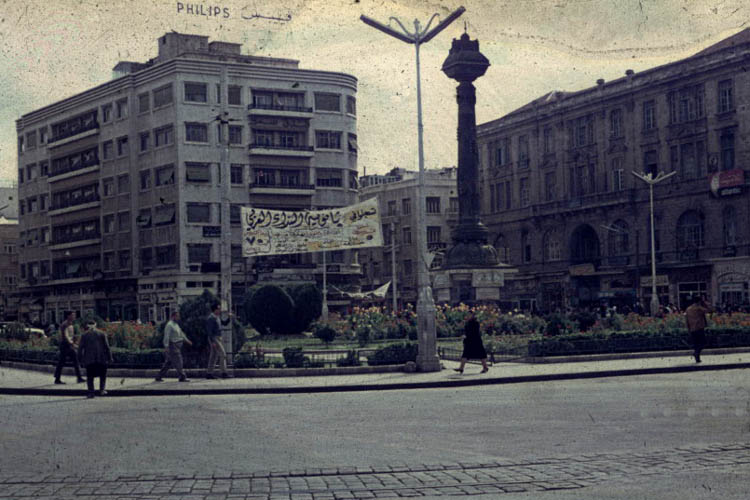
| Plaza in Damascus |
Jerusalem
Next day I did get back on the road to Jerusalem. There was a long line at the border to Jordan, but my taxi driver passed all the cars while shouting "Almani, Almani". Sometimes it's an advantage to be a German. So I passed the border quickly, after I did get my Jordan visa stamped into my passport.
My taxi stopped outside the old wall close to the Damascus gate. I walked through and relaxed first in a cafe on the Via Dolorosa, drinking tea while smoking the waterpipe.
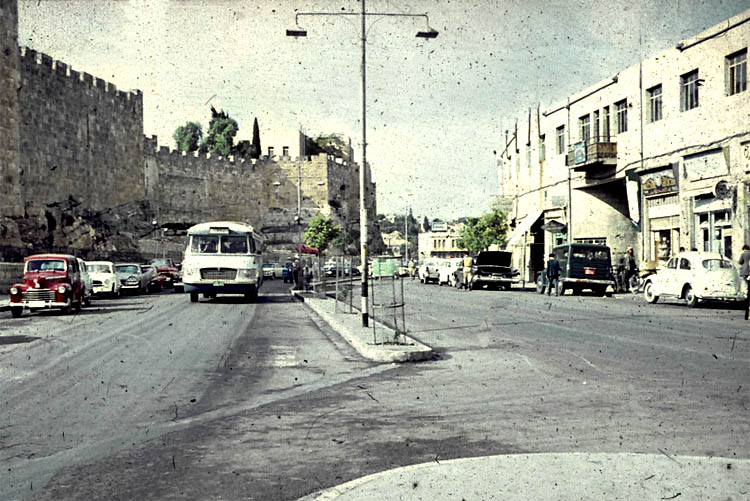
| Jerusalem Wall |

| Waterpipe smoker |
I met and talked with many other Palestinians. Some compared the wall in Jerusalem with the wall in Berlin, but at least Palestinians living in Israel could visit their relatives in Jordan, though always went back, because life was much better in Israel. No visits were possible the other way around. Berliners separated by the wall were not allowed to visit each other at all in those times.
There was a lot of complaining of the Palestinian refugees about their fate. But they also could have stayed in Israel right after it was founded like their relatives and many others. More than a million Arabs are Israel citizen and they are the only Arabs to enjoy real democracy with their own parties. And the Arabs who fled on their own and now stayed in their own chosen miserable refugee camps, defied all integration initiatives, and thus serving as a breeding ground for all the hatefulness against Israel which culminated into the Palestinian terrorists and suicide bombers later on (what if all the German refugees from Poland and the Czech Republic after WW II are still living in refugee camps).
This may not sound politically correct for many, who take the side of the Palestinian (a recent poll shows that the majority sympathizes with the underdog, right or wrong), but their situation was and still is their own fault, more or less. Also, if the Arab countries would not have provoked Israel with all the armor around Israel's borders threatening with an imminent attack in 1967, then Palestine would already exist today, provided Jordan would have ceded the West Bank to a new state of Palestine (why didn't Jordan do it before?).
Ok, let's get back to sight-seeing. Which was first the Temple Mount with the famous Dome of the Rock. It is the third holiest place for Muslims after, Mecca and Medina, and it stands on the site of the Temple of Solomon, the first Jewish temple. The place looked deserted: no muslims, no pilgers, no tourists, just me ... and the ambulant mocha dealer with his coffee pot (delicious).

| The famous Dome of the Rock |

| On Temple Mount in Jerusalem |
In one of the adjacent jeweler shops I also bought a nice pendant - with gold filigree around a gem topped with a holy cross and with a gold necklace for my mother for 50 DM. For me that was a lot of money at that time because I had only 600 DM with me in traveler checks (no credit card at that time). My mother could not believe that this was all gold, etc. and had it checked by a jeweler and ... it was all real. So she believed me that she was worth a lot to me.
After two days in Jerusalem I had to go all the way back to Damascus, where I changed the taxi for Lebanon, and then shortly after the Libanese border I took another taxi going north to Baalbek.

| From Jerusalem |
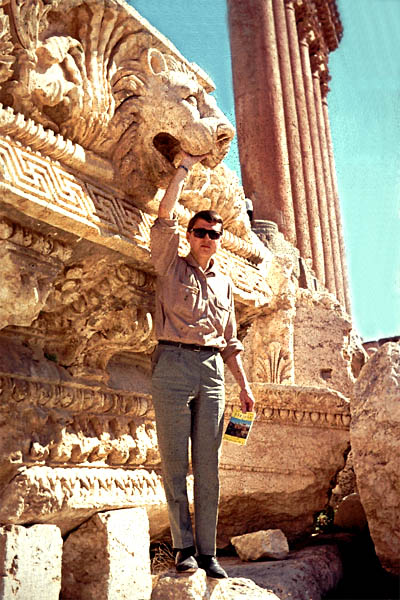
| to Baalbek |
Baalbek
Baalbek was build between the 1st and 3rd Century AD, also around the time Palmyra in Syria was a powerful city. Baalbek is the largest Roman temple complex known. And it is really fantastic. The temple of Jupiter had originally 59 Columns of which only 6 columns have survived. Each was 19m high with a diameter of 2.2m.
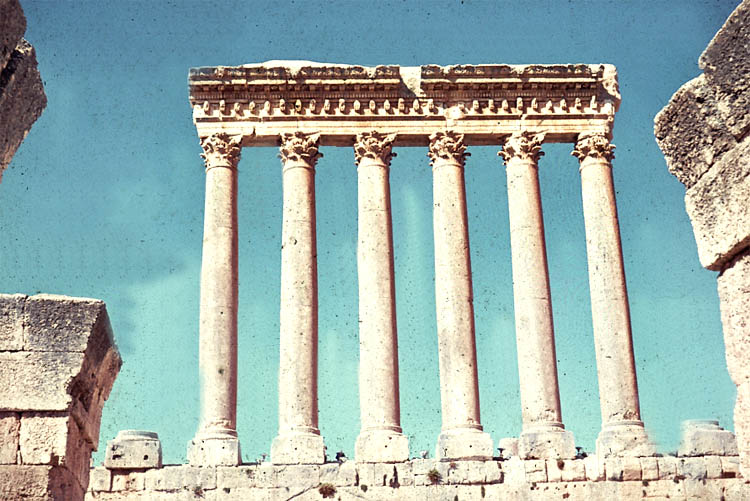
| Temple of Jupiter |

| Temple of Bacchus |
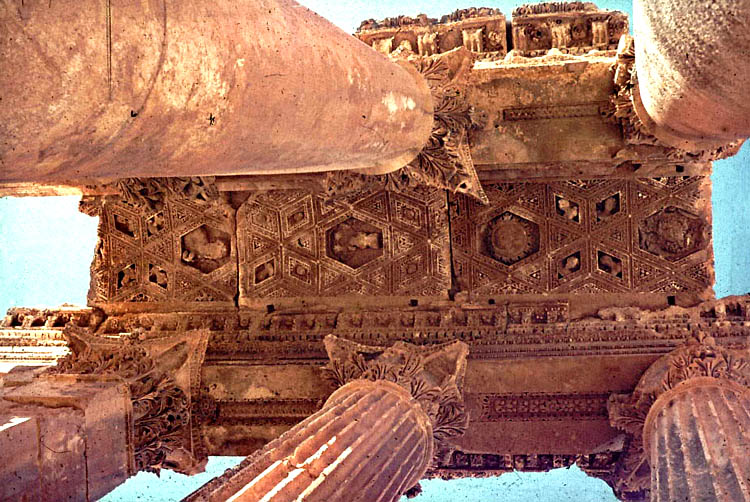
| Ballbek temple ceiling |
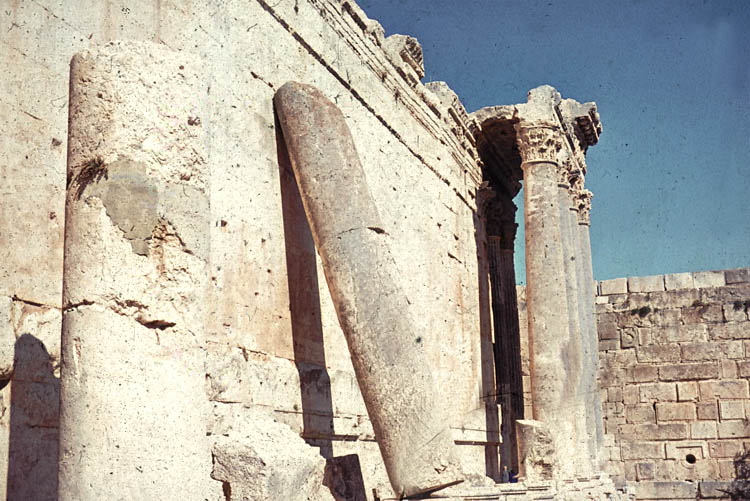
| Baalbek temple columns |
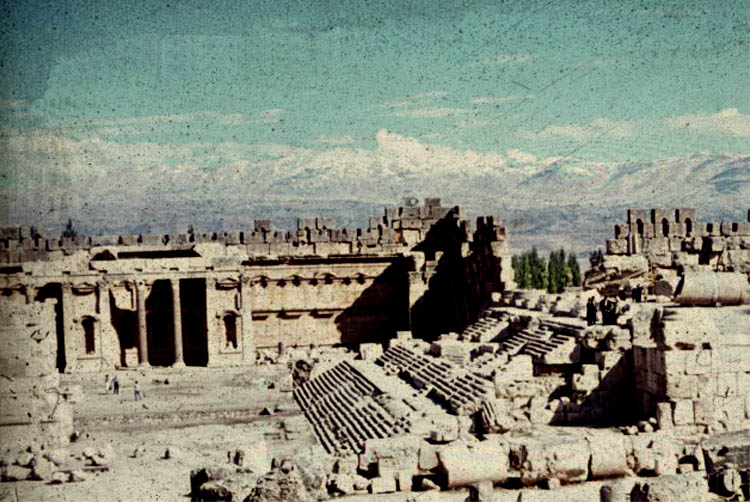
| Ballbek complex |

| Baalbek ruins |
Beirut
Ok, didn't have to escape in 1963 but was just trying to get to Beirut fast now. Back on the main Damascus-to-Beirut "highway" I was picked up by a taxi coming from Damascus. There was already one passenger inside who greeted me with "Guten Tag". I asked him astonished: "How do you know I am a German?". He answered that he recognizes every German even from a distance.
It turned out that he was a secretary of the Saudi Arabian Embassy in Bonn in Germany coming from an audience with King Ibn Saud in Vienna (curing there at that time), where he was instructed to see and deliver an important message to the Economy Minister of Saudi Arabia currently residing in Beirut.
His name was Talib and originally from Jiddah in Saudi Arabia. So was his friend Abdullah, whom I met when we arrived at Talib's hotel in Beirut. Abdullah also spoke German fluently, because he was studying in Munchen and had currently a trainee job at Siemens (we also met again a year later in Berlin). We all stayed together in their hotel room and also sticked together all the time in Beirut like old friends.
Abdullah lent me one of his jackets and a necktie, so I really looked like a diplomat, ready to visit the Economy Minister with Talib. He was residing on a whole floor of a five star hotel. I was not entitled to take part in the conference, though, but I stayed with one of the minister's secretaries and his chauffeur, a big Sudanese, maybe also a body guard.
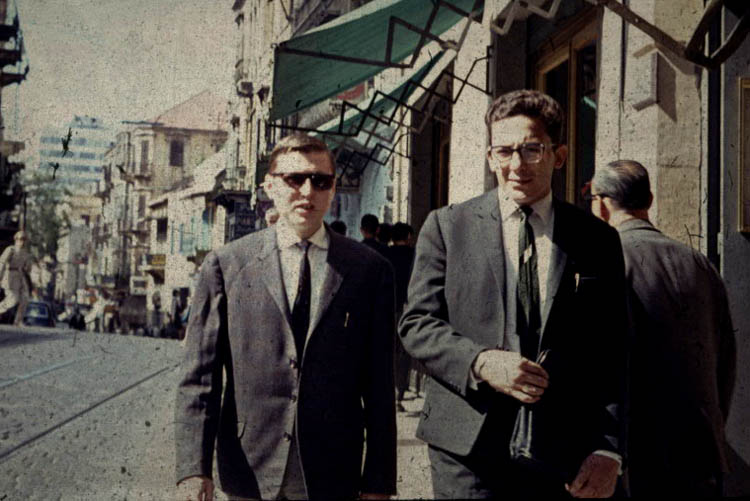
| With Talib in Beirut |

| With Abdullah in Beirut |
And it really was. No wonder that many Saudis flocked to this city. What was forbidden and harshly penalized at home was all allowed here. But, of course, for their Saudis back home, they were only doing business, because Beirut was also the banking center for the Middle East. What a pity that this fantastic place was devastated during the Lebanese Civil War (1975-1990).
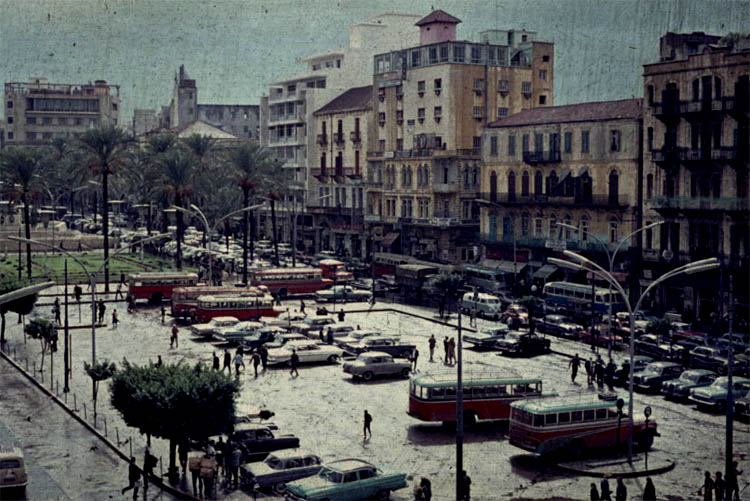
| Beirut main plaza |
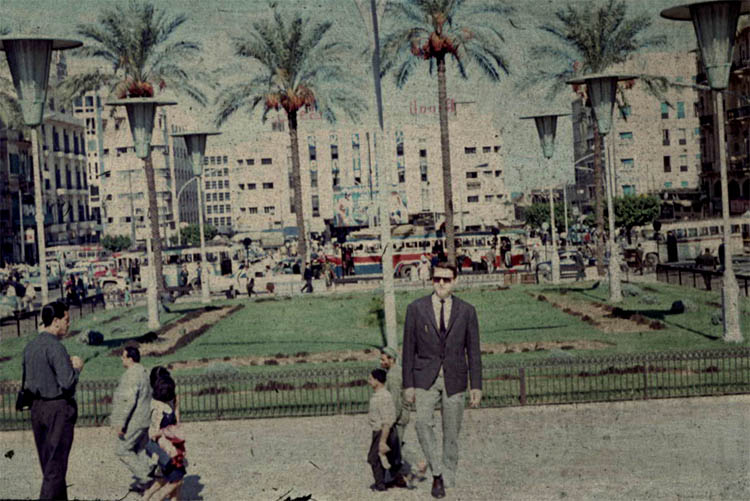
| Our man in Beirut |
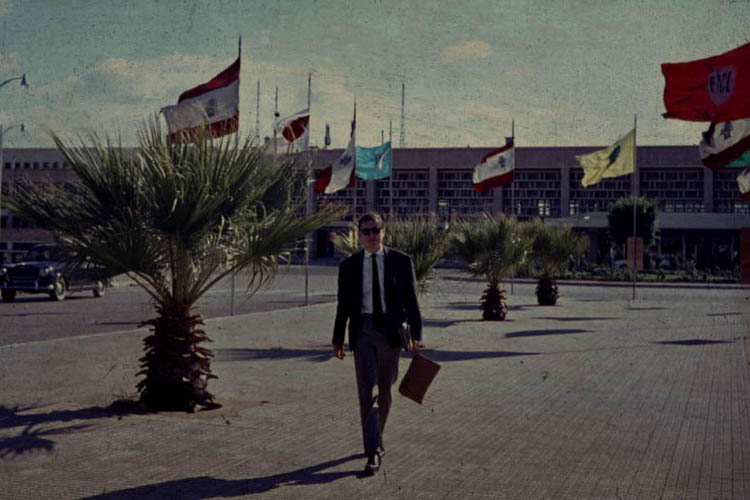
| In front of the Beirut Airport |
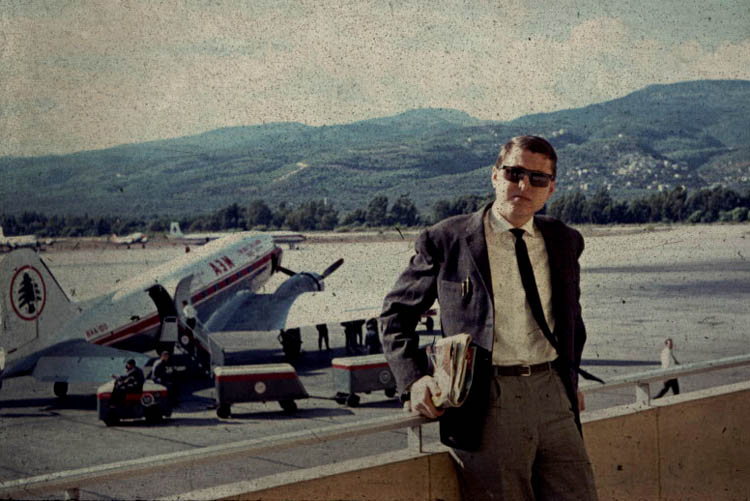
| No free ticket for flying |
My days were counted till I had to go back on the train to Germany. And I had one more piece of luggage to carry beside my rucksack: one nice large camel leather suitcase including a lot of souvenirs I bought for around 150 DM altogether in one of the many stores close to the harbor. It was almost a half day event with negotiating, joking and enjoying the courtesy mocha.
Ok, from Beirut I went all the way back to Aleppo by changing several taxis, where I boarded the Taurus Express again and in four days I was back in Cologne.
When I started in Germany I carried around 700 DM with me and when I came back I still had 200 DM, thus I only spent 500 DM for the whole trip (including 200 DM worth of souvenirs). That was the equivalent of 120 US Dollars (with an exchange rate of 4.20 DM for 1 USD at that time).
During my many talks I did get offers from Arabs (not the Economy Minister of Saudi Arabia though) to sell them "Made in Germany" stuff. One of the bigger items were used Mercedes Benz cars. I did not consider that seriously at first, but on the train I met two Germans, who just did that: personally driving a used Mercedes from Germany all the way to Jordan or Lebanon, selling it for double the price as what was paid in Germany.
Back in Germany I was planning to do the same next year together with Herbert from the train together with another guy, with a projected profit of 7,000 DM per car. That project, however, was "unfortunately" thwarted by a girl I fell in love with.